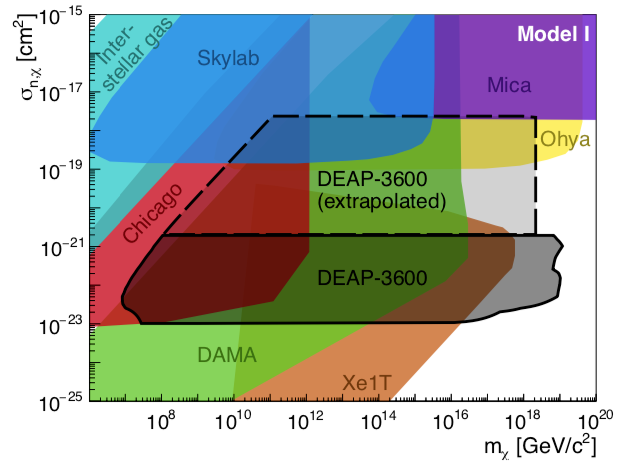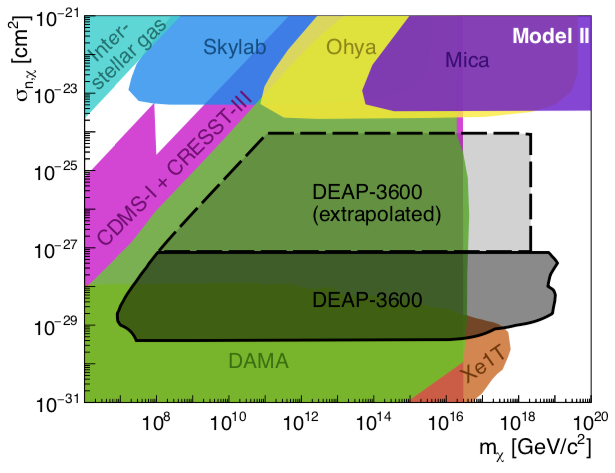Recontres de Moriond is probably the biggest ski-vacation conference of the year in particle physics, and is one of the places big particle physics experiments often unveil their new results. For the last few years the buzz in particle physics has been surrounding ‘indirect’ probes of new physics, specifically the latest measurement of the muons anomalous magnetic moment (g-2) and hints from LHCb about lepton flavor universality violation. If either of these anomalies were confirmed this would of course be huge, definitive laboratory evidence for physics beyond the standard model, but they would not answer the question of what exactly that new physics was. As evidenced by the 500+ papers written in the last year offering explanations of the g-2 anomaly, there are a lot of different potential explanations.
A definitive answer would come in the form of a ‘direct’ observation of whatever particle is causing the anomaly, which traditionally means producing and observing said particle in a collider. But so far the largest experiments performing these direct searches, ATLAS and CMS, have not shown any hints of new particles. But this Moriond, as the LHC experiments are getting ready for the start of a new data taking run later this year, both collaborations unveiled ‘excesses’ in their Run-2 data. These excesses, extra events above a background prediction that resemble the signature of a new particle, don’t have enough statistical significance to claim discoveries yet, and may disappear as more data is collected, as many an excess has done before. But they are intriguing and some have connections to anomalies seen in other experiments.
So while there have been many great talks at Moriond (covering cosmology, astro-particle searches for dark matter, neutrino physics, and more flavor physics measurements and more) and the conference is still ongoing, its worth reviewing these new excesses in particular and what they might mean.
Excess 1: ATLAS Heavy Stable Charged Particles
Talk (paper forthcoming): https://agenda.infn.it/event/28365/contributions/161449/attachments/89009/119418/LeThuile-dEdx.pdf
Most searches for new particles at the LHC assume that said new particles decay very quickly once they are produced and their signatures can then be pieced together by measuring all the particles they decay to. However in the last few years there has been increasing interest in searching for particles that don’t decay quickly and therefore leave striking signatures in the detectors that can be distinguished from regular Standard Model particles. This particular ATLAS search searches for particles that are long-lived, heavy and charged. Due to their heavy masses (and/or large charges) particles such as these will produce greater ionization signals as they pass through the detector than standard model particles would. This ATLAS analysis selects tracks with high momentum, and unusually high ionization signals. They find an excess of events with high mass and high ionization, with a significance of 3.3-sigma.

If their background has been estimated properly, this seems to be quite clear signature and it might be time to get excited. ATLAS has checked that these events are not due to any known instrumental defect, but they do offer one caveat. For a heavy particle like this (with a mass of ~TeV) one would expect for it to be moving noticeably slower than the speed of light. But when ATLAS compares the ‘time of flight’ of the particle, how long it takes to reach their detectors, its velocity appears indistinguishable from the speed of light. One would expect background Standard Model particles to travel close to the speed of light.
So what exactly to make of this excess is somewhat unclear. Hopefully CMS can weigh in soon!
Excesses 2-4: CMS’s Taus; Vector-Like-Leptons and TauTau Resonance(s)
Paper 1 : https://cds.cern.ch/record/2803736
Paper 2: https://cds.cern.ch/record/2803739
Many of the models seeking to explain the flavor anomalies seen by LHCb predict new particles that couple preferentially to tau’s and b-quarks. These two separate CMS analyses look for particles that decay specifically to tau leptons.
In the first analysis they look for pairs of vector-like-leptons (VLL’s) the lightest particle predicted in one of the favored models to explain the flavor anomalies. The VLL’s are predicted to decay into tau leptons and b-quarks, so the analysis targets events which have at least four b-tagged jets and reconstructed tau leptons. They trained a machine learning classifier to separate VLL’s from their backgrounds. They see an excess of events at high VLL classification probability in the categories with 1 or 2 reconstructed tau’s, with a significance of 2.8 standard deviations.

In the second analysis they look for new resonances that decay into two tau leptons. They employ a sophisticated ’embedding’ technique to estimate the large background of Z bosons decaying to tau pairs by using the decays of Z bosons to muons. They see two excesses, one at 100 GeV and one at 1200 GeV, each with a significances of around 3-sigma. The excess at ~100 GeV could also be related to another CMS analysis that saw an excess of diphoton events at ~95 GeV, especially given that if there was an additional Higgs-like boson at 95 GeV diphoton and ditau would be the two channels it would likely first appear in.

While the statistical significances of these excess are not quite as high as the first one, meaning it is more likely they are fluctuations that will disappear with more data, their connection to other anomalies is quite intriguing.
Excess 4: CMS Paired Dijet Resonances
Paper: https://cds.cern.ch/record/2803669
Often statistical significance doesn’t tell the full story of an excess. When CMS first performed its standard dijet search on Run2 LHC data, where one looks for a resonance decaying to two jets by looking for bumps in the dijet invariant mass spectrum, they did not find any significant excesses. But they did note one particular striking event, which 4 jets which form two ‘wide jets’, each with a mass of 1.9 TeV and the 4 jet mass is 8 TeV.

This single event seems very likely to occur via normal Standard Model QCD which normally has a regular 2-jet topology. However a new 8 TeV resonance which decayed to two intermediate particles with masses of 1.9 TeV which then each decayed to a pair of jets would lead to such a signature. This motivated them to design this analysis, a new search specifically targeting this paired dijet resonance topology. In this new search they have now found a second event with very similar characteristics. The local statistical significance of this excess is 3.9-sigma, but when one accounts for the many different potential dijet and 4-jet mass combinations which were considered in the analysis that drops to 1.6-sigma.
Though 1.6-sigma is relatively low, the striking nature of these events is certainly intriguing and warrants follow up. The Run-3 will also bring a slight increase to the LHC’s energy (13 -> 13.6 TeV) which will give the production rate of any new 8 TeV particles a not-insignificant boost.
Conclusions
The safe bet on any of these excesses would probably be that it will disappear with more data, as many excesses have done in the past. And many particle physicists are probably wary of getting too excited after the infamous 750 GeV diphoton fiasco in which many people got very excited (and wrote hundreds of papers about) a about a few-sigma excess in CMS + ATLAS data that disappeared as more data was collected. All of theses excesses are for analyses only performed by a single experiment (ATLAS or CMS) for now, but both experiments have similar capabilities so it will be interesting to see what the counterpart has to say for each excess once they perform a similar analysis on their Run-2 data. At the very least these results add some excitement for the upcoming LHC Run-3–the LHC collisions are starting up again this year after being on hiatus since 2018.
Read more:
CERN Courier Article “Dijet excess intrigues at CMS”
Background on the imfamous 750 GeV diphoton excess, Physics World Article “And so to bed for the 750 GeV bump“
Background on the LHCb flavor anomalies, CERN Courier “New data strengthens RK flavour anomaly“

















